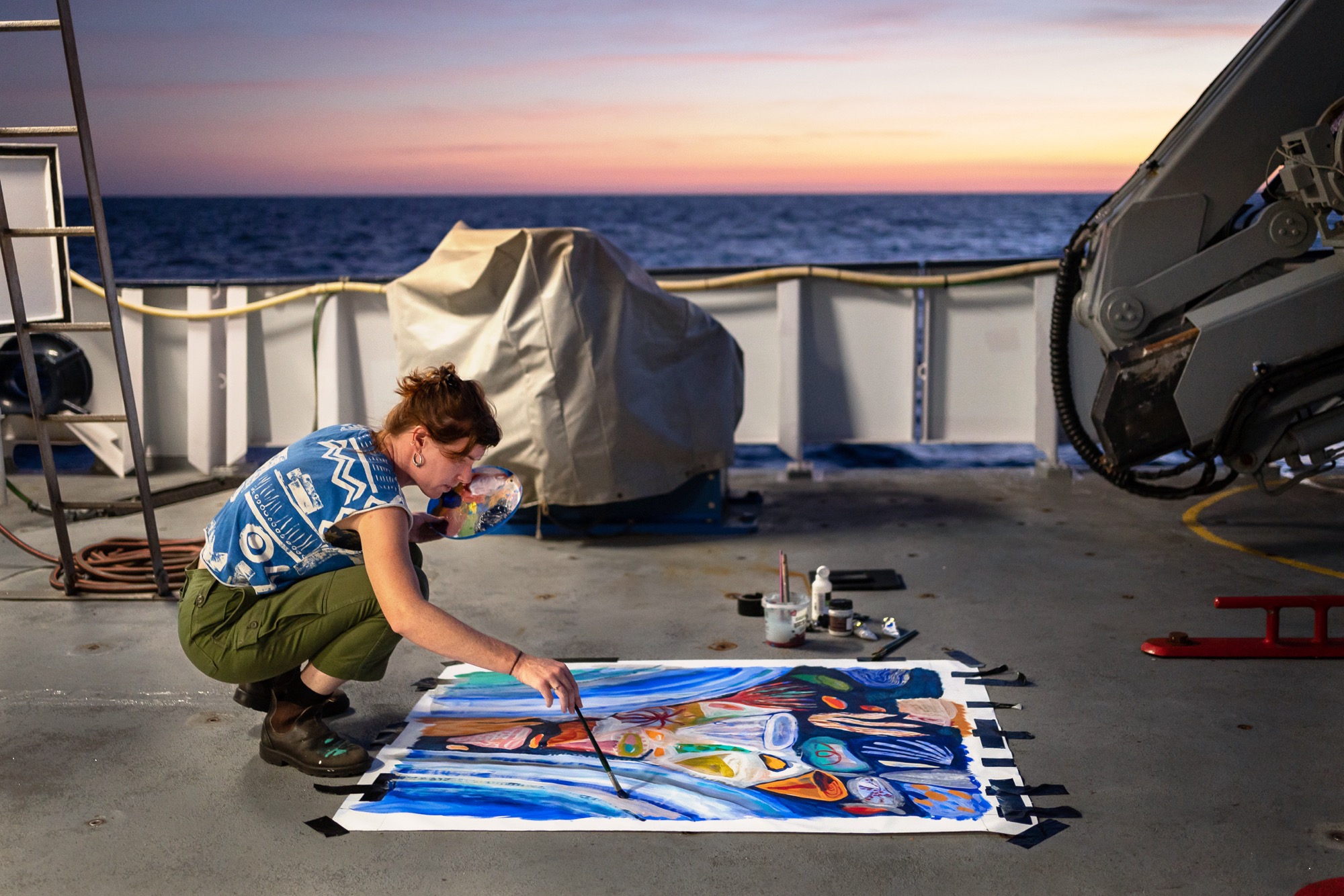This post was originally published on Colossal
“There are many ways to tell a story or to document and share research and discoveries,” says artist Ellie Hannon, one of 54 artists who has embarked on a unique residency organized by the Schmidt Ocean Institute (previously). From slip-cast porcelain and painting to 3D printing and virtual reality, the storytelling possibilities are endless in the Artist-at-Sea program, which invites artists to work alongside scientists on weeks-long expeditions into some of the least-explored areas of our oceans.
Conceived by the organization’s co-founder and president Wendy Schmidt and launched in 2015, the residency was fueled by suggestions from some of the crew onboard its first vessel, Falkor—named after the beloved luck dragon in The NeverEnding Story. “The idea behind the program was to provide an avenue for artists to experience the scientific process at sea and experience first-hand new ocean ecosystems,” says Dr. Carlie Wiener, the institute’s director of communications.

Aboard the research vessel Falkor (too), one artist is provided with a berth—an alotted space—on each expedition, exploring a wide range of biological and geological phenomena. From volcanic activity to coral reefs to glacial interactions, researchers often document new species, map uncharted terrain, and examine the implications of the climate crisis seen in receding ice sheets and rising sea levels.
Designers Shan Hua and Pei-Win Jin joined a six-day journey in August 2023 dedicated to studying the dynamics of sinking microplastics. The residency was an opportunity to experiment with new technology, while observing how tests were carried out and learning about the physical characteristics of the ocean. Hua says, “It was my first time collaborating with scientists, and it was incredibly memorable to observe their sampling processes over an extended period.”
For her work on Falkor (too), Hua was deeply moved by the reality of vast quantities of plastics in our oceans and the capacity for the material to last an incredibly long time without breaking down, unlike organic material. A single-use plastic bottle can take hundreds of years to disintegrate. But in the ocean, the most worrisome culprits are the tiny particles that can starve and suffocate marine life, while also possibly hindering the ocean’s ability to act as a carbon sink.
“Something as simple as laundering synthetic fabrics can introduce microplastic fibers into the environment,” says a statement about the last August’s expedition. Hua looked further into the longevity of microplastics and its effects on life, landing on the theme of marine fossils. She worked with an onboard 3D printer, along with VR technology, to create what she calls “future fossils”—relics portending what might happen if we don’t act now to prevent further pollution.
For the artists aboard Falkor (too), working alongside scientists fosters a deeper appreciation for the enormity of our oceans and the life they contain. Costa Rica-based Carlos Hiller, who specializes in underwater landscape painting, was constantly awed by the sights and discoveries during the nearly three-week “Octopus Odyssey” expedition around the west coast of his home island.
“I became an invisible witness to the encounter between technology—our underwater eyes—and organisms or landscapes that had never seen the light before.”
Carlos Hiller
Hiller expected to have long periods to paint, and he imagined that the remotely operated vehicle (ROV) that scanned the sea floor would be slow and monotonous. But there wasn’t a dull moment: “Every few meters on the sedimentary floor, a new creature appeared, and the rock formations revealed underwater landscapes that evoked vivid descriptions of 20,000 Leagues Under the Sea,” he says.

The human relationship to the sea struck a chord with Hiller, who was intrigued by parallel yet disparate experiences. “I was fascinated by placing myself imaginarily at a certain distance from the ROV to observe the scene from two angles: that of the observed and that of the observer,” he says. “I became an invisible witness to the encounter between technology—our underwater eyes—and organisms or landscapes that had never seen the light before.”
Hiller created 13 paintings onboard the vessel, and the experience inspired a further series of paintings, murals, and small, mobile sculptures informed by the deep environment. “Often, we imagine the sea as a vast, undulating surface, an infinite mirror,” he says. “We venture only a few meters underwater, and beyond that, in our minds, there is only darkness, emptiness, and mystery.” He is thrilled by the apprehension of so much more.

Hannon also took advantage of the ROV’s capabilities during a 2021 residency focused on paintings and a slip-cast porcelain installation. She collaborated with researcher Ian Parnum and ROV technician Jason Rodriguez as the team explored Ashmore Reef Marine Park, a sanctuary for birds, turtles, and many other marine species off Australia’s northwest coast.
Using digital imaging—and the ROV’s robot arms—to capture the visual characteristics of a sea sponge, Hannon was able to digitally stitch together a 3D image, which was then printed into a slip-cast mold. The process reinvigorated an aspect of her practice she had previously put to the side. She also produced a series of five vibrant paintings illustrating a wide range of creatures inhabiting the reef.
“One of the most surprising things that has come out of the program is not just how the science has influenced the artist but how the art has influenced the science.”
Dr. Carlie Wiener
Wowed by the clarity of the ROV’s film footage and the work of its operators, Hannon disembarked with a lasting impression of inventiveness and creativity demonstrated by the entire team. “A moment that stuck out for me relating to this was, when a part of the ROV broke, the team used the 3D printer to replicate this part, as they noted: you can’t just run down to the tool shop when you are 400 kilometers from land.”

Interacting with researchers from around the world provides artists the opportunity to reimagine scientific inquiry as a range of art forms and share discoveries and technologies through an approachable medium. Schmidt Ocean Institute then adds one piece from each artist to its collection, exhibiting the work globally in a continued effort to advance knowledge about the marine world.
“One of the most surprising things that has come out of the program is not just how the science has influenced the artist but how the art has influenced the science,” Dr. Wiener says. “Many of our Artist-at-Sea participants have developed long-term relationships with scientists that come aboard and continue to work together on projects after their time in the residency.”
Another recent expedition invited Max Hooper Schneider onboard, and Jill Pelto is working on the current trip off the coast of Chile, which concludes on September 23. Learn more about the Artist-at-Sea program and take a deep dive into each expedition on the Schmidt Ocean Institute’s website.


Do stories and artists like this matter to you? Become a Colossal Member today and support independent arts publishing for as little as $7 per month. The article Art and Science Set Sail in Schmidt Ocean Institute’s Artist-at-Sea Program appeared first on Colossal.




0 Comments